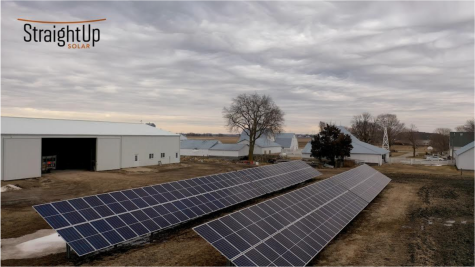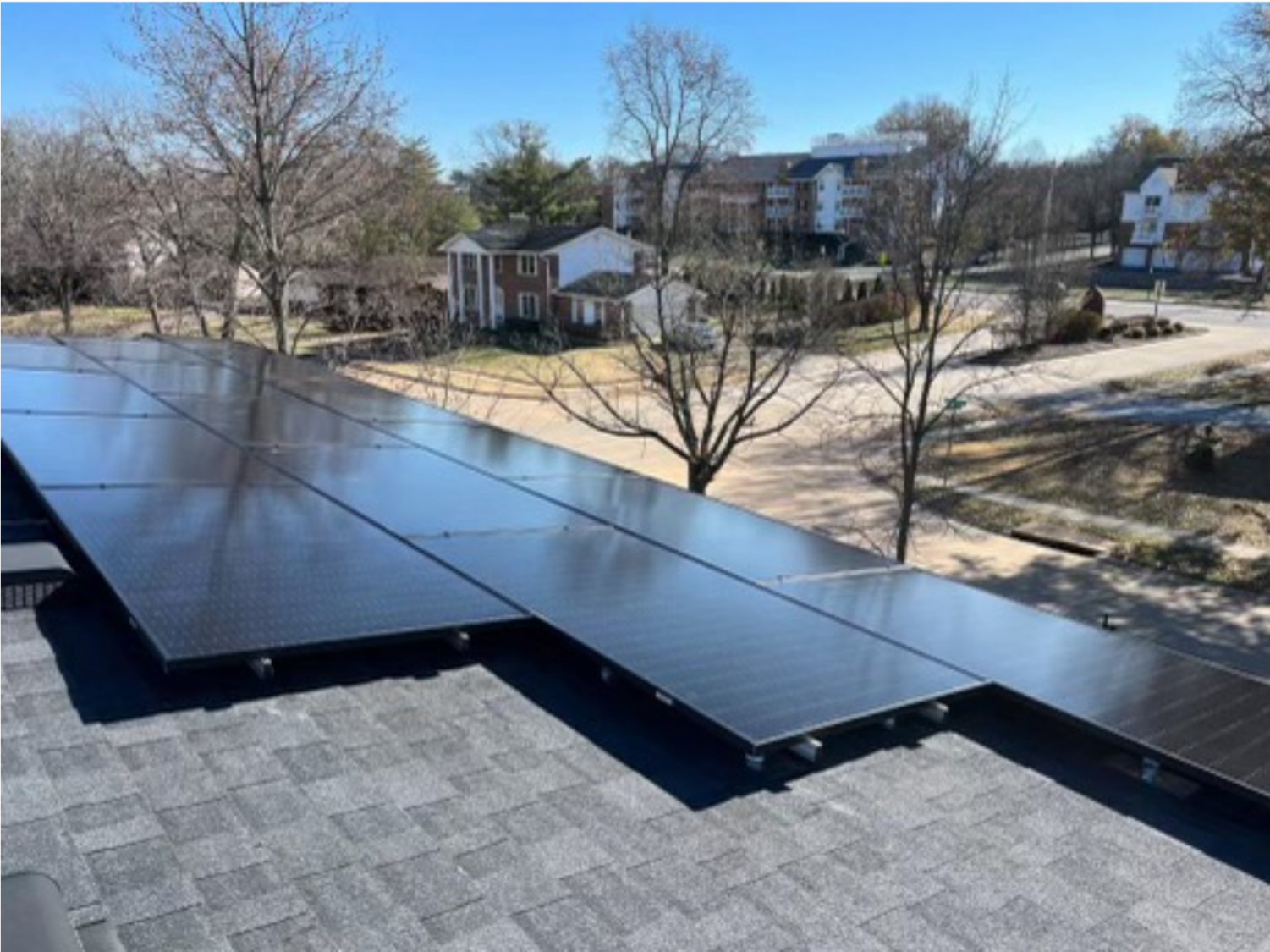Your donation will support the student journalists of Marquette High School. Your contribution will allow us to purchase equipment and cover our annual website hosting costs. You may become a PATRON by making a donation at one of these levels: White/$30, Green/$50, Blue/$100. Patron names will be published in the print newsmagazine, on the website and once per quarter on our social media accounts.
In-Depth: Renewable Revolution
Renewable energy expands in the Midwest, affecting the Marquette community
February 3, 2023
It was only about two months ago that Silvia Portolan, mother of Adriano Robins, senior, had 15 solar panels installed on the roof of her house, now obtaining electricity from the sun.
“It’s pretty cool when you’re viewing it from the street,” Robins said. “If you’re going down Clayton, you can see my mom’s house, and it has all the solar panels.”
Portolan said she was planning to have the panels installed much earlier.
“The installation was delayed because there was a lot of demand,” she said.
Portolan’s installer was Titan Solar Power; however, many other companies are essential to this process. This includes solar manufacturers, installers, loaners and app/interface companies that allow solar users to view the amount of energy they are producing with an app on their phone.
It cost Portolan $20,000 for the whole system; however, the government gave her $7,500 and Ameren gave her $1,500.
“I am not going to be paying Ameren because I’m producing energy for them now, so instead of paying my electric bill, I pay the company that loaned me the money to install the solar panels,” Portolan said.
There is often an abundance of energy, and the excess is sold back to the surrounding grid, she said. Solar companies try to put customers in a place where they fulfill their energy needs with solar and make a little extra energy that can be shared with others.
Portolan does not have battery storage for the energy she produces, so her power source still needs to be switched back to the grid at night when no electricity is being produced from solar. Occasionally, heavy cloud cover and snow can also inhibit energy production. Despite this, Portolan has already saved over 500 kilowatt-hours of electricity this winter.
“I haven’t had it long enough to be able to do the math, but eventually it will be in my favor,” Portolan said. “Just like when you begin anything, you have to take the leap of faith knowing that you’re doing the right thing.”
Portolan’s home is one of 4% of houses nation-wide that have solar panels installed. U.S. solar power capacity has grown from 0.34 Gigawatts (GW) in 2008 to about 97.2 GW today, and The Department of Energy estimates that more than one in seven U.S. homes will have a rooftop solar photovoltaic (PV) system by 2030.
Changes in the Industry
Shannon Fulton, vice president of development at Straight Up Solar, said the company is evolving with a rapidly growing market in the Missouri/Illinois region.
Straight Up Solar, with headquarters in St. Louis; Bloomington, Illinois; and Marion, Illinois, is a solar developer and an Engineering, Procurement and Construction (EPC) company. This means they both develop and build solar projects.

“The Midwest was one of the last areas for solar to really start growing significantly and taking root, and we’re there right now. It’s really incredible to see,” Fulton said.
A significant change occurring in the industry in the U.S. is an increasing amount of solar modules being produced domestically. Fulton explained the importance of the Inflation Reduction Act in helping to incentivize this. The act created tax credits and many funding opportunities for renewables.
A downside of this growth in domestic manufacturing is an increase in the cost of solar.
In previous decades, costs decreased significantly, but this shift in the market has caused increases for the past two years. Fulton said added incentives for renewables will still foster market growth, even through this period of higher prices.
“There are some limiting resource factors on the horizon,” Fulton said.
Silicon, a semi-conductor of electricity, is the main component of solar panels, and lithium is an essential component of batteries that are often used to store solar electricity. Both of these resources are fairly abundant, but they are still limited.
Despite this, Fulton is optimistic about discoveries in solar research, with new developments potentially greatly improving solar energy production.
Ameren’s Approach
Scott Wibbenmeyer, senior director of renewable development and acquisitions at Ameren Missouri, has a background in nuclear and fossil fuel energy production, while spending about half of his career, 10 years, focused on renewables.
“I lead all of our renewables,” Wibbenmeyer said. “The way we meet our goals is we either buy projects or we develop them ourselves. I manage all of those projects and all the folks that go along to execute those projects.”
Wibbenmeyer said about 11% of the total energy Ameren produces comes from renewables.
“Most of that right now, when we look at it in Missouri, is from wind,” he explained.
Ameren has recently begun to expand solar production as well, with the ultimate goal of creating a balance between the two. Wibbenmeyer said following this approach helps manage the variability of production.
“When the sun shines during the day, we’ll get solar energy,” he said. “When it’s blowing wind, typically at night, we’ll get more energy at night from wind.”
In the next 15 years, Ameren plans to install more renewable energy centers to produce just under 5400 MW of solar and wind (2700 MW of wind, 2700 MW of solar) to replace fossil fuel energy generation.
In achieving this large goal, there come many challenges and considerations.
“When we look at solar development, a key challenge we have is making sure we’re picking the right location, so it has good terrain, and so it can produce the most and install it at the least cost,” Wibbenmeyer said.
Another element of finding the best location involves environmental considerations. Wibbenmeyer said it is always the overarching goal to ensure the environment is not negatively impacted by new renewable projects.
“We try to balance that when we’re looking at locations, as well as community engagement,” Wibbenmeyer said. “We’re putting solar plants, sometimes in place of a corn field, to grow electrons instead of corn. Landowners are usually part of that project, and we have a lot of support internally.”
Minimizing rates and ensuring energy prices remain affordable also encourages Ameren to focus on only the most valuable renewables projects.
Recent Challenges
The new surge of demand, Wibbenmeyer said, has resulted in some difficulties.
“There’s just not enough production out there for the amount of solar being put in in the U.S., so that’s really driven cost up,” he said.
Wibbenmeyer mentioned that the U.S. is in a small trade war with China over solar panel production, which is the reason for increased domestic production.
“The U.S. is putting tariffs and making it harder to import and more costly to import those modules into the U.S., primarily to drive up our own manufacturing base,” Wibbenmeyer said. “That’s not a bad thing, but it’s definitely making it a challenge to transition and get solar projects built in the next 5 years.”
Despite some recent price increases, Wibbenmeyer said improving efficiencies in solar technology and construction will continue to drive down costs. Overall, he said, installing many renewables now will be very beneficial for us in the future.
“We have been very fossil heavy for 70 plus years, and when we look at that fossil fleet, it will be retired because it’s aging out,” Wibbenmeyer said. “It’s just getting old.”
This is why, as Wibbenmeyer noted, it will become critical for Ameren to transition to new sources of energy, with renewables as the best option. Creating renewable infrastructure now ensures Ameren’s customers will have the energy they always depend on when they flip on the switch, he said.
“Sometimes we think we just turn the switch on and it’s there, but there’s a lot in the background going on to make that happen,” he said.
Impacts at Marquette
Kevin Koch, AP Environmental Science teacher, has 24 solar panels on his roof supplying 40-60 percent of his energy usage.
“Any electricity I generate that I don’t use goes directly back to the grid, and the electric company credits me for the kWh I supply to the grid,” he said.
So far, Koch said he has generated 19.8 MWh of electricity and saved 30,661 lbs of CO2 from entering the environment, the equivalent of planting 232 trees.
In his class, Koch helps engage students with renewable energy.
“We discuss the different energy sources and then build a ‘City of the Future’ that tries to use as many renewable energy sources as possible,” he said.
Koch said he is optimistic about the future of renewables, especially with many extended tax credits and rebates from the federal government, state government and utility companies.
Silvia Portolan shares this optimism about solar energy’s future and hopes others will join her in going solar.
“We are a community and have to start somewhere,” she said. “I’m the first one in my neighborhood, but hopefully when they start seeing that I’m not paying energy bills anymore, maybe people are going to start making changes.”


